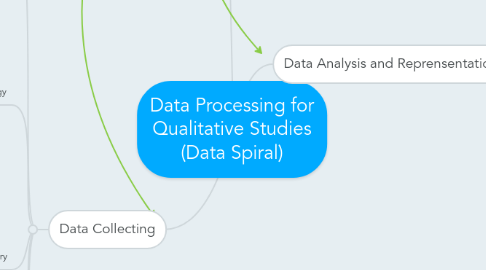
1. Data Collecting
1.1. Biography
1.1.1. accessible individual
1.1.2. interview
1.1.3. maybe access to diarys or other personal records
1.1.4. chats
1.1.5. notes
1.1.6. collected data is in computer and notebooks, etc
1.2. Phenomenology
1.2.1. group individuals, experienced
1.2.2. interviews, depth
1.2.3. willing to share story
1.2.4. edges
1.2.5. records & transcriptions
1.3. Grounded Theory
1.3.1. group as subject of study
1.3.2. control group?
1.3.3. interview, not so deep, might be a questionnaire
1.3.4. research the homogeneous majority and add details with the minority
1.3.5. samples
1.4. Ethnography
1.4.1. gatekeeper!
1.4.2. observation from the edge of stranger
1.4.3. participation
1.4.4. tons of field notes
1.5. Case Study
1.5.1. individuals in a case
1.5.2. gatekeeper!
1.5.3. be sharper and sharper, find the case of case
1.5.4. other records: news, reviews
1.5.5. observation and interviews
1.5.6. notes
2. Computer
2.1. Nudist (???!!!!!)
2.2. Nvivo
3. Data Analysis and Reprensentation
3.1. Biography
3.1.1. chronology of life
3.1.2. storytelling
3.1.3. search larger patterns and meanings from the interviews
3.1.4. narration
3.1.5. Where id unique of your subject of research?
3.1.6. identify: when who where what
3.2. Phenomenology
3.2.1. horizonaliziton of the data
3.2.2. what's the meaning the phenomenon have
3.2.3. find commonness and characteristics
3.2.4. what and how, edges
3.2.5. tell the essence
3.3. Grounded Theory
3.3.1. open,axial and selective
3.3.2. central
3.3.3. select information needed
3.3.4. axial and open coding
3.3.5. make or prove a theory /model?
3.4. Ethnography
3.4.1. culture-sharing
3.4.2. researchers are storytellers
3.4.3. classifying
3.4.4. interpret the observation result
3.4.5. narrative with anything show the true circumstances, might be funny
3.5. Case Study
3.5.1. natuaralistic
3.5.2. tell the case
3.5.3. how what and WHY choose this case
3.5.4. categorical aggregation
3.5.5. tables and figures

